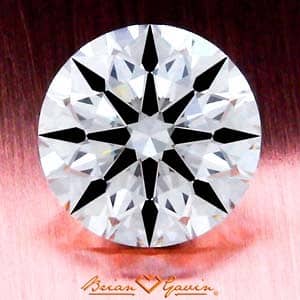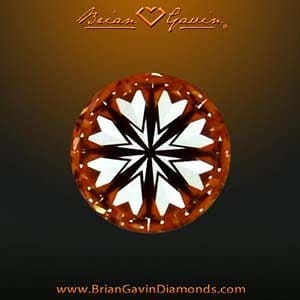Creators of the Leo Diamond claim it's the "first-ever diamond ever independently certified to be visibly brighter," but that is a matter of perspective.
First, it's essential to understand how they use the word brightness as a defining characteristic. It's also important to know why the Leo Diamond sparkles differently than other round brilliant cut diamonds.
The short explanation is that the Leo Diamond features sixty-six facets instead of fifty-eight. In other words, the patented design results from splitting more significant facets into smaller sections.
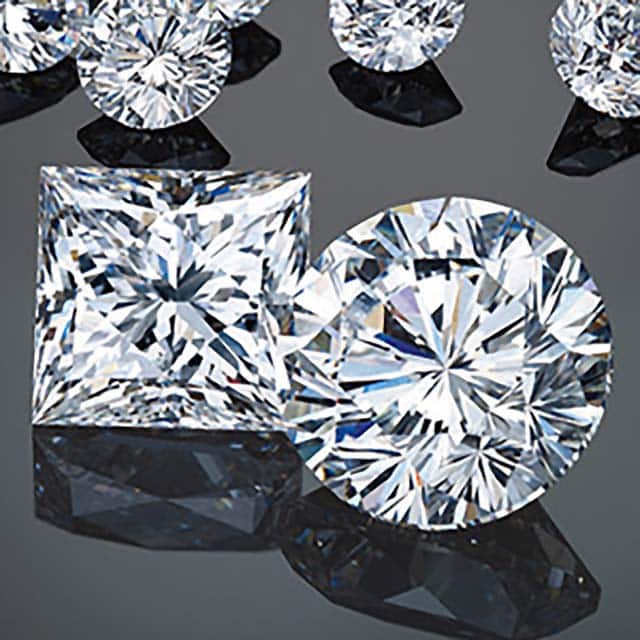
Leo Diamonds Round and Princess Cut.
While that may produce more sparkle, it also splits the sparkle into smaller pieces. In that case, the Leo Diamond appears more brilliant, but there's a hidden catch.
The downside is that the human eye cannot disperse smaller flashes of white light into colored sparkle. Under those circumstances, the diamond is brighter because it is more brilliant but lacks dispersion or fire.
Are Leo Diamond Reviews Reliable?
Most of the Leo Diamond Reviews that you'll find online are by people who love their Leo Diamond. In the first place, this is helpful because you probably want to know whether people like their Leo Diamond.
At the same time, there is the matter of distinct cognitive bias that occurs after somebody makes a buying decision. Consequently, most product reviews are subject to Choice-supportive bias or post-purchase rationalization.
People Tend To Recommend What They Buy:
That might explain why the Leo Diamond is popular with people who shop at Jared® and Kay® Jewelers. After all, it stands to reason that people should be mesmerized by the sparkle factor of their engagement ring.
In contrast, I haven't been impressed by the Leo Diamonds that I've seen. Splitting the facets into smaller sections produces an effect that I don't find appealing.
It also makes Leo Diamonds look like crushed ice from my perspective. Perhaps that's why the Leo is the "first diamond ever independently certified to be visibly brighter."
Do you see how the light reflecting throughout the Leo Diamond has a splinter-like property? If that's your preference, there's nothing wrong with it, but it's essential to understand the cause and effect.
Consequently, I prefer more significant reflections that produce broad-spectrum sparkle. I also like the balance of brilliance (white sparkle) and dispersion (fire) that Hearts and Arrows diamonds exhibit.
Leo Diamonds FAQ:
This Leo Diamond Review will help you answer the common questions below and more. At the same time, you'll learn what factors are likely to affect your perception of brilliance, dispersion, and scintillation.
The nature of this review will be different than most because I have 35+ years experience as a diamond buyer. In that case, I'm not going to try and convince you that the Leo Diamond is good nor bad. Obviously, because that is a matter of perception. Under those circumstances, my aim is to explain what distinguishes the Leo from a modern round brilliant cut diamond.
Is the Leo Diamond Good?
Obviously, determining whether or not Leo Diamonds are good is largely a matter of personal preference. I suppose the answer depends on what type of sparkle factor you prefer.
As you'll discover below, the Leo Diamond exhibits specific visual properties that will be appealing to some people. However, you might decide that you prefer a diamond that offers more of a balance of brilliance and dispersion.
Are Leo Diamonds Certified?
The Leo Diamonds which I've seen come with a lab report from Gemological Services International (GSI). To be perfectly blunt, this is not a very well known gemological laboratory. Suffice to say that I prefer the grading standards of the AGS & GIA gemological laboratories.
In addition, it's worth noting that these labs issue diamond grading reports, not certificates. The fact of the matter is that a diamond grading report does not certify anything. It merely reports the characteristics of the diamond at the time it was submitted for grading.
Are Leo Diamonds Conflict Free?
With regards to whether Leo Diamonds are conflict free, I fully expect that they originate from reputable sources. The parent company, Leo Schachter is well-known and highly reputable. As a matter of fact, the occurrence of "conflict diamonds" is practically unheard of in this modern age outside the movies.
Is the Leo Diamond brighter than other diamonds?
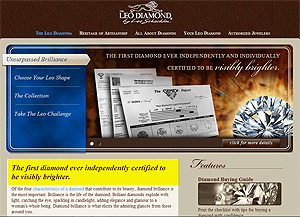
Leo Diamond Details Page.
According to the producers of the Leo Diamond, it's the "first ever diamond ever independently certified to be visibly brighter." A screenshot of that statement as seen on their website appears to the left.
Be that as it may, the truth behind that advertising jargon might not be as impressive as it first seems. Let's begin by breaking that sentence down and evaluating it piece by piece. It clearly says that the Leo Diamond is the "first diamond ever independently certified to be visibly brighter.”
Although this may be true, notice that nobody is saying that the Leo is the brightest diamond available. The sentence merely states that the Leo is "the first diamond to be independently certified as being visibly brighter."
STOP and read between the lines!
For the most part, this only means that it was the first diamond sent to GemEx for this purpose. As a matter of fact, the statement does not say that the Leo is the only diamond certified for brightness.
So what does this sentence mean to you as a diamond buyer? In truth, it means absolutely nothing, despite what all of those Leo Diamond Reviews will tell you. In my opinion, this is little more than marketing jargon or what I consider to be tergiversation.
That's essentially hyperbole with a clever spin on it so it sounds more impressive. For some reason, practically all of the Leo Diamond Reviews online seem to repeat this nonsense.
Of course, there is always likely to be some truth in advertising or it would be fraudulent and illegal. With this in mind, we're going to delve deeper into the definition of brightness and brilliance. After all, it's the vague differences in this terminology that the advertising guru's are playing upon.
Diamond Brilliance & Brightness Defined:
From a gemological perspective, the term "Brightness” refers to internal and external reflections of white light. Consequently, we judge brightness by viewing the diamond in the face-up position. That makes sense because that is how you’ll be viewing the diamond in a ring, right?
In the same fashion, it is common for consumers to use describe diamonds in terms of brilliance and brightness. However, in this scenario, people tend to mistake brightness for brilliance and that's the rub.
As a matter of fact, the term "Brilliance” is used to describe the volume of light return. However, brilliance also describes the "perception of intensity” created by the internal and external reflections of white light. Again this is judged by looking at the diamond in a face-up position.
The Effect of Contrast Brilliance:
The "perception of intensity” can also result from a high level of contrast brilliance. This can be seen within the light and dark regions of the Brian Gavin Signature diamond on the left.
This diamond is cut with the 57 facet structure, which is standard for a traditional round brilliant cut diamond.
By the way, it's worth mentioning that this diamond has proportions that meet my selection criteria. As a result, it will produce a high volume of light return and exhibit a virtual balance of brilliance and dispersion.
For the purpose of this discussion, that last point is a rather critical concept. To put it another way, this diamond will exhibit a virtual balance of white sparkle and fire. Whereas the Leo Diamond is more likely to exhibit more brilliance at the expense of dispersion.
Creating a More Brilliant Looking Diamond:
There are two ways to increase the brilliance (white sparkle) of a round brilliant cut diamond. The first approach is to adhere to a very tight range of proportions that maximizes the volume of light return.
Then, polish the facets of the diamond to a higher degree of optical precision. The combination of these two factors will produce a virtual balance of brilliance and dispersion. However, it can take up to four times longer to polish a diamond to that level of perfection.
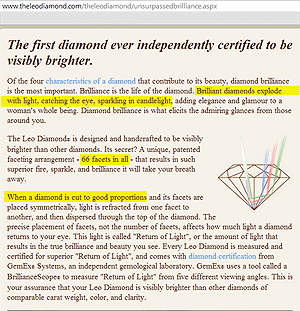
Is the Leo Diamond Brighter?
The second approach is to simply increase the number of facets on the diamond. This has the effect of increasing the number of virtual facets which are created by the overlapping of physical facets.
As a matter of fact, that will create more sparkle and people like the sound of that. After all, everybody wants to see more sparkle in their diamond, am I right? This is probably why the Leo Diamonds feature 66 - 82 facets depending on the collection.
However by increasing the number of virtual facets, the flashes of light are actually smaller in size. And when sparkle is smaller in size, our eyes are unable to diffuse the light into full spectral colors, thus the light is primarily interpreted as brilliance.
Maximizing Brilliance, Dispersion, and Scintillation:
Remember that "brilliance” refers to the white sparkle seen reflecting from a diamond. While "dispersion" refers to sparkles of different colors or what is commonly known as fire. Scintillation is the sparkle that occurs when you or the diamond is moving.
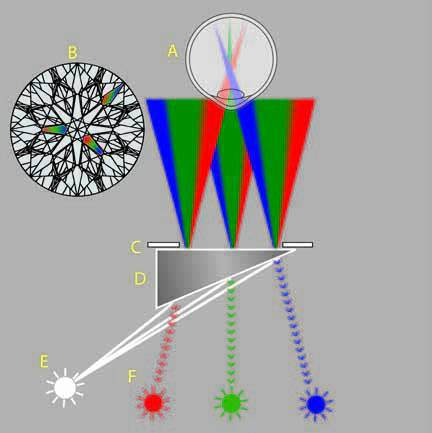
Effect of Virtual Facets on Dispersion.
The image to the left shows a typical pattern of "virtual facets" seen within a traditional round brilliant cut diamond. The modern round brilliant cut diamond features 57 facets divided into eight equal sections. As light reflects throughout the diamond it creates "virtual facets" as seen on the left.
Generally speaking, all of the light reflecting from a diamond is white light. Our eyes will disperse the resulting sparkle into different colors if it is large enough. The gemological term for the rainbow sparkle effect is dispersion or fire.
Sparkle which is smaller in size will not be dispersed into different colors by our eyes. As a matter of fact, sparkle that is smaller in size will be seen as brilliance or white sparkle. This is why modified rounds like the Leo appear to be brighter.
In other words, increasing the number of facets on a diamond splits the light into smaller pieces. In turn, this produces more brilliance (white sparkle) which makes the diamond seem brighter. However, the increase in brilliance will likely be at the expense of dispersion or fire.
Truth in Advertising:
Take a moment to examine the advertising material that promotes modified round brilliant cut diamonds. To be specific, that is any round that features more or less than the traditional 57 facets. Upon doing so, you will see that practically all of them describe their diamonds like this:
Of course, these advertising claims are accurate because of the way that our eyes interpret the sparkle. Remember that smaller sparkle is most likely to be seen as brilliance and not dispersion.
Leo Diamond Facet Diagram:
The graphic below is courtesy of Leo Schachter and shows the facet structure of the 82-facet Leo Diamond.
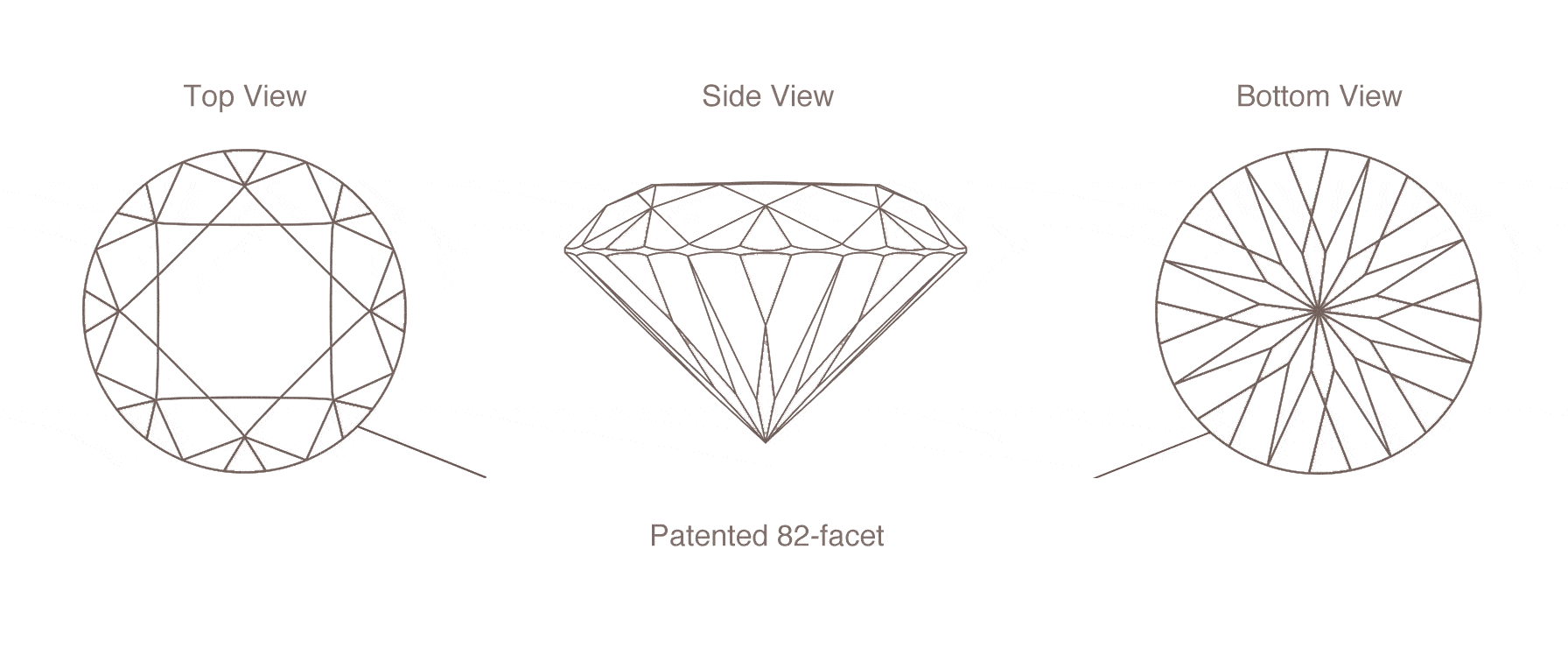
Leo Diamond Facet Structure.
The top view shows that the upper girdle facets are split apart with a triangle in the middle. At the same time, the lower girdle facets in the side view reveals the addition of two extra facets. The bottom view shows how these facets combine to split the light apart into smaller pieces.
From a gemological perspective, this explains why the Leo Diamond appears to be brighter. On the other hand, it also demonstrates why the Leo Diamond might not exhibit as much "Fire" as a traditional round.
You'll notice that I'm not trying to convince you whether the optical properties of the Leo are good or bad. Given the reality that everybody has their own preferences, my goal is simply to help you better understand the options.
Creating a Virtual Balance of Brilliance and Dispersion:
At the same time, I openly admit that I prefer the look of a traditional round brilliant cut diamonds. That is to say that I'm visually drawn to diamonds that exhibit a virtual balance of brilliance and dispersion. Of course, this means selecting a diamond within a precise range of proportions.
Brian Gavin Signature diamonds are cut to exhibit a higher degree of optical precision. This produces the Hearts and Arrows pattern visible on the left.
The hearts pattern is a reflection of the higher degree of optical precision. To put it another way, the hearts pattern is a result of precision craftsmanship.
I'll openly admit that being able to produce a hearts pattern within a diamond is pretty amazing! However, that by itself is not a reason to pay a premium for a hearts and arrows diamond.
The most compelling reason to buy a hearts and arrows diamond is the light performance. As a matter of fact, Black by Brian Gavin Diamonds exhibit the most spectacular light performance I've ever seen.
At the same time, I think that hearts and arrows ideal cut diamonds look better in practically every lighting environment. Whereas modified round brilliant cut diamonds seem to look their best under jewelry store lighting.
With this in mind, I'm more likely to select one of the following brands of hearts and arrows diamonds:
Are You Buying a Diamond?
Feel free to ask for my assistance whether you are buying a diamond online or from a local store. I'm happy to help you look over the details and provide additional insight.
If by chance you are buying a Leo Diamond, I would love to see ASET and Ideal Scope images. That would enable us to determine the degree of light leakage and see whether the diamond is reflecting light evenly.

